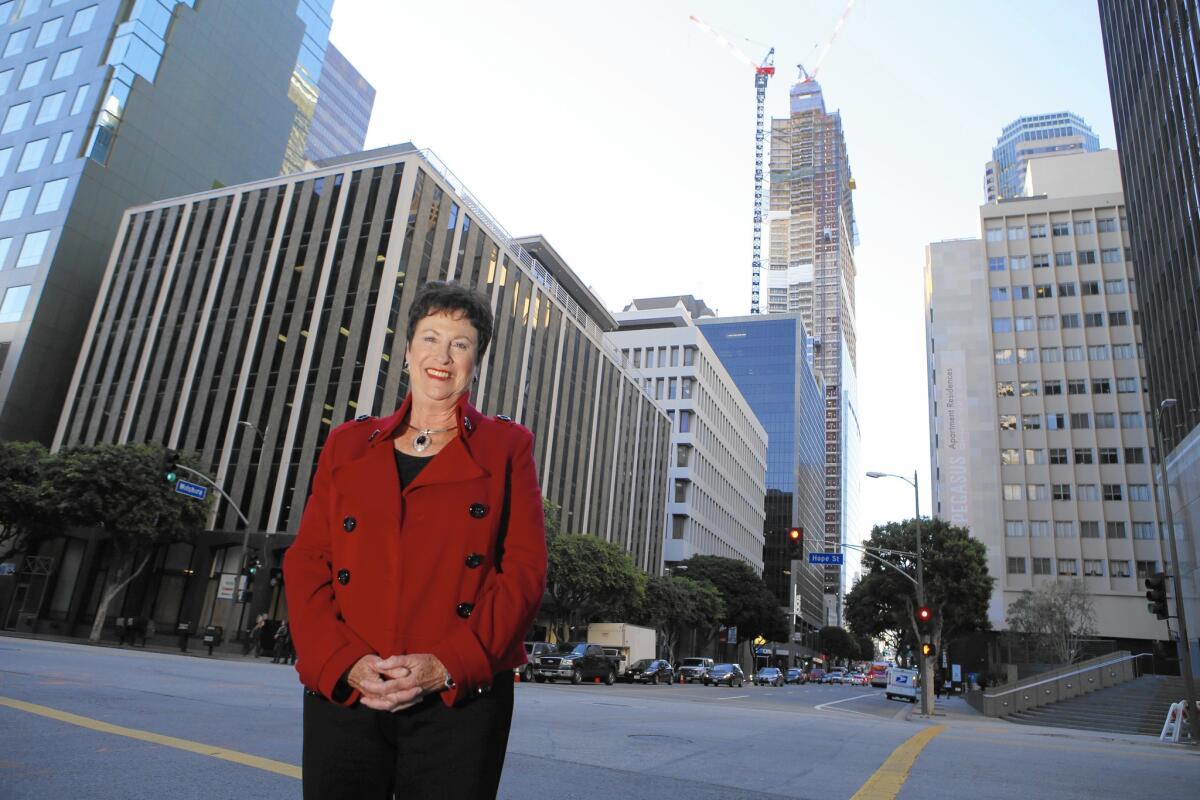Q&A: ‘Everything has changed’ in downtown L.A., Central City Assn. chief Carol Schatz says

- Share via
As the longtime head of the Central City Assn., Carol Schatz has helped guide downtown Los Angeles’ transition from a “ghost town” after 5 p.m. to a bustling city center that has captured international attention.
The business advocacy group has pushed for two of the major initiatives credited with luring investment and people to the area: Staples Center and the adaptive-reuse ordinance that made it easier to renovate old office buildings into housing. She also runs the Downtown Center Business Improvement District, which helps fund security, marketing and economic development efforts.
Now the 68-year-old chief executive, who has held her post since 1995, plans to leave the association by the end of the year and the improvement district in a “couple of years.”
Having two full-time jobs simply became too much, Schatz said, though she will consult for the Central City Assn. for a while after a successor is picked.
The Times sat down with Schatz to talk about the past, present and future of downtown. The interview has been edited for space and clarity.
Since you’ve arrived, downtown has become a vibrant place full of residents, bars, restaurants and entertainment. Is there something the city center still lacks?
I want more of everything. We are focusing on bringing more creative tech to downtown, whether it’s in a funky old building or in a high-rise. We want to see a much greater array of retail.
Now we are getting shopping options. In the very beginning it was bargain shopping. Now we are seeing some higher end. That is great. What I think is going to be key is making sure that it’s both eclectic retail and that it appeals to all income levels. I am not interested in created a yuppie town.
What was your memory of downtown when you first arrived at the Central City Assn. in 1990?
It was dark, empty and dreary and it felt unsafe after it got dark. It was blighted in many areas; it was not clean in many areas. Everything has changed.
Why was housing so critical in the transformation?
It was moving the downtown from just a vertical office park to a multiuse downtown. We decided housing was going to change things and we needed to create a critical mass of residents.
So we worked with the city to get the adaptive-reuse ordinance passed and that went into effect in 1999, about six months before Staples Center opened. The adaptive-reuse ordinance, Staples were the critical things.
Now that private investment is booming, should the city still play a role?
Absolutely the city has a role to play. L.A. has always had, through this whole course of my tenure here, this reputation of a very business unfriendly place and it has scared off investment. Oftentimes when investment leaves, we don’t don T-shirts and go into the [City Council] chambers and chant. We just go quietly.
What the city should be doing — and Building and Safety I know has made this a priority — is everything the city can to encourage the investment and help it get through. The big push now is to get more people hired that can push these projects through — [the] Planning [Department] in particular. Delay in processing is a killer of economic growth.
Are there other policy proposals that should be undertaken?
We would like to see more density downtown, some of those [height] restrictions removed. You want to be able to build as high as you can in the place where it makes the most sense to densify, especially with us being the hub of the transit system.
One recent policy change was the removal of the requirement that tall buildings have a rooftop helicopter landing pad for emergencies, which was blamed for L.A.’s flat-topped skyline. How will this change downtown?
It’s going to be huge. There was a whole skyline that was sort of restricted as a result of this. You don’t have this in Manhattan. What makes for exciting downtowns is really iconic architecture. Now we are able to really say to the architect go for it, you can design something that is spectacular.
What are the biggest remaining obstacles for downtown?
The quality-of-life issues. So the homeless issue is a very critical one. It’s probably the most complicated issue that the entire country faces, but it has a particular importance to downtown.
Investors — this is just from a straight commercial point of view — that are coming from other countries, other cities don’t see this — the tents, the structures and so forth — and it’s unnerving for them. And clearly for our residents, if they get harassed, if they feel unsafe, they are not going to stay.
Does the business community have role to play?
It has been playing a role the entire time I have been in [the Central City Assn.]. If you take a look at the boards of directors of the providers in downtown, there is a huge number of businesspeople who are serving, who helped to fund-raise. And the business community stands ready to assist in any way.
[But] the bottom line is that given the amount of housing and the amount of services that are required, especially with addiction and mental illness, the bulk of that funding has to come from government.
So I take it you support the recent proposal by state legislators to spend $2 billion on housing for the homeless?
[It] was something that we were very pleased to hear and will support in any way — in terms of political support or whatever.
As you look back over the last 20 years, what was your biggest disappointment?
I can’t say really that I have a great disappointment, except to say in general terms that I wish that the business community in general got more respect from our elected officials and from the public too.
What would you consider your biggest accomplishment?
The fact that we are able to make this big play for the Olympics. We now have a real city to sell them and we didn’t in 1984. We finally have a real 24/7 downtown. That is the thing I am most proud of.
Twitter: @khouriandrew
More to Read
Inside the business of entertainment
The Wide Shot brings you news, analysis and insights on everything from streaming wars to production — and what it all means for the future.
You may occasionally receive promotional content from the Los Angeles Times.











